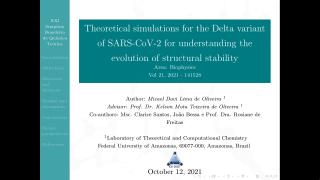Anais do Simpósio Brasileiro de Química Teórica
Anais do XXI Simpósio Brasileiro de Quimica Teórica - Vol. 1 2021
IN SILICO PROSPECTING INHIBITORS GLUTAREDOXIN A1 OF CORYNEBACTERIUM PSEUDOTUBERCULOSIS
Como citar esse trabalho?
Para citar este trabalho use um dos padrões abaixo:
Como citar esse trabalho?
- Tipo de apresentação: Apresentação de Pôster / Poster Communications
- Eixo temático: Biofísica
- Palavras chaves: Homology modeling; molecular dynamics; Virtual Screening;
- 1 Universidade Federal de Mato Grosso do Sul
- 2 Universidade Federal do Tocantins
IN SILICO PROSPECTING INHIBITORS GLUTAREDOXIN A1 OF CORYNEBACTERIUM PSEUDOTUBERCULOSIS
Charlene Marcondes Avelar
Universidade Federal de Mato Grosso do Sul
Agora você poderia compartilhar comigo suas dúvidas, observações e parabenizações
Crie um tópico- Tipo de apresentação: Apresentação de Pôster / Poster Communications
- Eixo temático: Biofísica
- Palavras chaves: Homology modeling; molecular dynamics; Virtual Screening;
- 1 Universidade Federal de Mato Grosso do Sul
- 2 Universidade Federal do Tocantins
Caseous lymphadenitis (CL) is an infectious disease caused by the pathogenic microorganism Corynebacterium pseudotuberculosis (Cp) and causes great economic losses in livestock farming worldwide.
In this context, when understanding the aspects of bacterial defenses, in silico approaches can assist in inhibition strategies of this mechanism.
In summary, the present work aims to search for possible inhibitors of the GrxA1 protein of C. pseudotuberculosis, through computational simulations by Molecular Dynamics (DM) and Virtual Screening (VS).
The three-dimensional structure of GrxA1 was constructed by homology in its active form and, in sequence, simulated for 200 ns with the DM technique.
In the second stage, using molecular docking and Virtual Screening, we found a total of 26 molecules with the potential inhibitor of GrxA1.
Although still in the preliminary phase, the study paves the way for the development of new medicines and biotechnological applications, contributing to assist in the treatment and/or cure of Caseous Lymphadenitis, thus generating great interest for this sector of the economy.
pH utilizado e otimização dos ligantes
Vinícius Bonatto
Oi Charlene, bem legal essa proposta que vocês estão realizando. Você tem ideia de quanto seria o pH em ensaios enzimáticos? Pois você disse que checou os estados de protonação utilizando pH = 7.4. Vocês pretendem realizar otimização nesses ligantes também? Obrigado e parabéns pelo trabalho.
- 2 respostas
Discussões Científicas de Qualidade
Com ~200 mil publicações revisadas por pesquisadores do mundo todo, o Galoá impulsiona cientistas na descoberta de pesquisas de ponta por meio de nossa plataforma indexada.
Confira nossos produtos e como podemos ajudá-lo a dar mais alcance para sua pesquisa:
Como citar esse proceedings?
Esse proceedings é identificado por um DOI , para usar em citações ou referências bibliográficas. Atenção: este não é um DOI para o jornal e, como tal, não pode ser usado em Lattes para identificar um trabalho específico.
Verifique o link "Como citar" na página do trabalho, para ver como citar corretamente o artigo



Charlene Marcondes Avelar
Olá Vinícius,
O pH ótimo da proteína é esse 7.4, essa referência foi encontrada em um artigo experimental. Iremos fazer Dinamica Molecular com os 26 compostos, para uma análise do detalhamento do acoplamento proteína/ligante e depois partimos para a otimização somente com as interações de melhores resultados.
Vinícius Bonatto
Oi Charlene, muito obrigado pela resposta, ficou bem claro. Abraços.